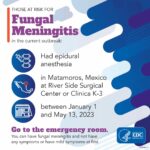Candida Non-albicans and Non-auris Causing Invasive Candidiasis in a Fourth-Level Hospital in Colombia: Epidemiology, Antifungal Susceptibility, and Genetic Diversity
24 Ιουλίου, 2024
Fungal Meningitis Outbreak Associated with Procedures Performed under Epidural Anesthesia in Matamoros, Mexico
23 Σεπτεμβρίου, 2024Abstract
Resistance in dermatophytes is an emerging global public health issue. We, therefore, developed an agar-based method for screening Trichophyton spp. susceptibility to terbinafine (TRB), itraconazole (ITC), and amorolfine (AMF) and validated it using molecularly characterized isolates. Α total of 40 Trichophyton spp. isolates, 28 TRB wild type (WT) (13 T. rubrum, 10 T. mentagrophytes, 5 T. interdigitale) and 12 TRB non-WT (7 T. rubrum, 5 T. indotineae) with different alterations in the squalene epoxidase (SQLE) gene, were used. The optimal test conditions (inoculum and drug concentrations, incubation time, and temperature) and stability over time were evaluated. The method was then applied for 86 WT Trichophyton spp. clinical isolates (68 T. rubrum, 7 T. interdigitale, 6 T. tonsurans, 5 T. mentagrophytes) and 4 non-WT T. indotineae. Optimal growth of drug-free controls was observed using an inoculum of 20 µL 0.5 McFarland after 5-7 days of incubation at 30°C. The optimal concentrations that prevented the growth of WT isolates were 0.016 mg/L of TRB, 1 mg/L of ITC, and 0.25 mg/L of AMF, whereas 0.125 mg/L of TRB was used for the detection of Trichophyton strong SQLE mutants (MIC ≥0.25 mg/L). The agar plates were stable up to 4 months. Inter-observer and inter-experimental agreement were 100%, and the method successfully detected TRB non-WT Trichophyton spp. strains showing 100% agreement with the reference EUCAST methodology. An agar-based method was developed for screening Trichophyton spp. in order to detect TRB non-WT weak and strong mutant isolates facilitating their detection in non-expert routine diagnostic laboratories. (see more)
Siopi M, Efstathiou I, Arendrup MC, Meletiadis J.J Clin Microbiol. 2024 Jan 17;62(1):e0130823. doi: 10.1128/jcm.01308-23
